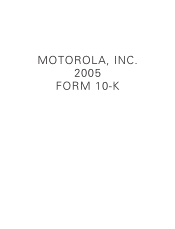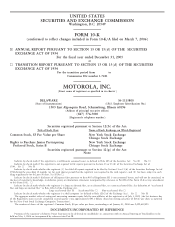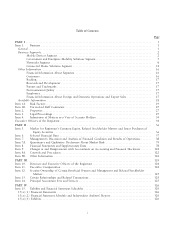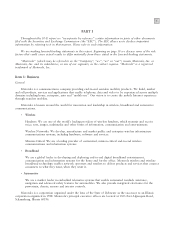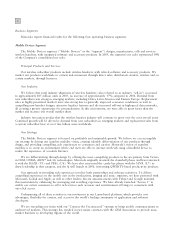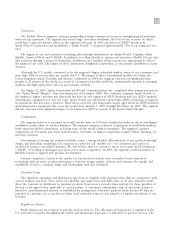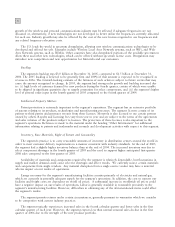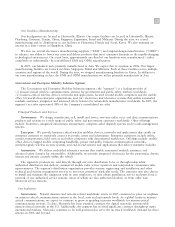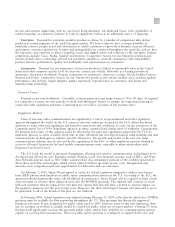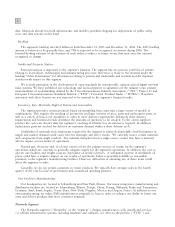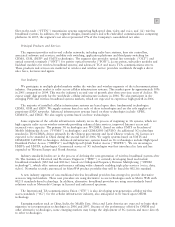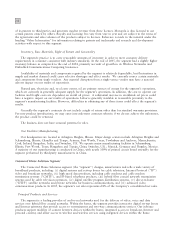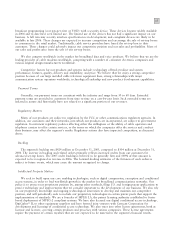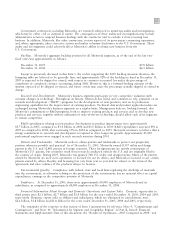Motorola 2005 Annual Report Download - page 15
Download and view the complete annual report
Please find page 15 of the 2005 Motorola annual report below. You can navigate through the pages in the report by either clicking on the pages listed below, or by using the keyword search tool below to find specific information within the annual report.
8
data. Motorola already has both infrastructure and mobiles/portables shipping for deployment of public safety
voice and data systems in this band.
Backlog
The segment's backlog was $2.4 billion at both December 31, 2005 and December 31, 2004. The 2005 backlog
amount is believed to be generally firm, and 75% is expected to be recognized as revenue during 2006. The
forward-looking estimate of the firmness of such orders is subject to future events that may cause the amount
recognized to change.
Intellectual Property Matters
Patent protection is important to the segment's business. The segment has an extensive portfolio of patents
relating to its products, technologies and manufacturing processes. Reference is made to the material under the
heading ""Other Information'' for information relating to patents and trademarks and research and development
activities with respect to this segment.
We actively participate in the development of open standards for interoperable, mission-critical digital two-way
radio systems. We have published our technology and licensed patents to signatories of the industry's two primary
memorandums of understanding defined by the Telecommunications Industry Association (""TIA'') Project 25 and
European Telecommunications Standards Institute (""ETSI'') Terrestrial Trunked Radio (""TETRA''). Royalties
associated with these licenses are not expected to be material to the segment's financial results.
Inventory, Raw Materials, Right of Return and Seasonality
The segment provides custom products based on assembling basic units into a large variety of models or
combinations. This requires the stocking of inventories and large varieties of piece parts and replacement parts, as
well as a variety of basic level assemblies in order to meet delivery requirements. Relatively short delivery
requirements and historical trends determine the amounts of inventory to be stocked. To the extent suppliers'
product life cycles are shorter than the segment's, stocking of lifetime buy inventories is required. In addition,
replacement parts are stocked for delivery on customer demand within a short delivery cycle.
Availability of materials and components required by the segment is relatively dependable, but fluctuations in
supply and market demand could cause selective shortages and affect results. We currently source certain materials
and components from single vendors. Any material disruption from a single-source vendor may have a material
adverse impact on our results of operations.
Natural gas, electricity and, to a lesser extent, oil are the primary sources of energy for the segment's
operations, which are currently in generally adequate supply for the segment's operations. In addition, the cost to
operate our facilities and freight costs are dependent on world oil prices. A substantial increase in worldwide oil
prices could have a negative impact on our results of operations. Labor is generally available in reasonable
proximity to the segment's manufacturing facilities. However, difficulties in obtaining any of these items could
affect the segment's results.
Generally, we do not permit customers to return products. We typically have stronger sales in the fourth
quarter of the year because of government and commercial spending patterns.
Our Facilities/Manufacturing
Our headquarters are located in Schaumburg and Deer Park, Illinois. Our major integration, manufacturing and
distribution facilities are located in: Schaumburg, Illinois; Tianjin, China; Penang, Malaysia; Berlin and Taunusstein,
Germany; Arad, Israel; Sequin, Texas; Elma, New York; Nogales, Mexico; and Angers, France. In addition to our
own manufacturing, we utilize EMS manufacturers, primarily in Asia, in order to enhance our ability to lower our
costs and deliver products that meet consumer demands.
Networks Segment
The Networks segment (""Networks'' or the ""segment'') designs, manufactures, sells, installs and services:
(i) cellular infrastructure systems, including hardware and software, (ii) fiber-to-the-premise (""FTTP'') and


